This is part of a set of walkthroughs I posted on the knifemaking 101 list on facebook. Since I went to the trouble to do all the photography and editing I thought I may as well keep them here, too, in case anyone ever starts searching for this sort of material.
Here we are using Alumilite water clear liquid epoxy resin, pigment, and inclusions to produce possibly interesting-looking handle materials. These are intended to be epoxied in turn to the sides of a knife’s tang and shaped down into blades. Elsewhere I describe the process for making the kind of silicone mold that I’m using here [stderr] – if you want a block mold for an inserted/drilled-through tang, you’d simply make a square mold out of a different master.
The hardest part for me to figure out was how tiny an amount of pigment or glitter is necessary to change the looks of resin mix. In this example, I’m using 1/3 of a drop of blue pigment (make the drop hang on the end of the pigment bottle and twirl a bit off with a popsicle stick)
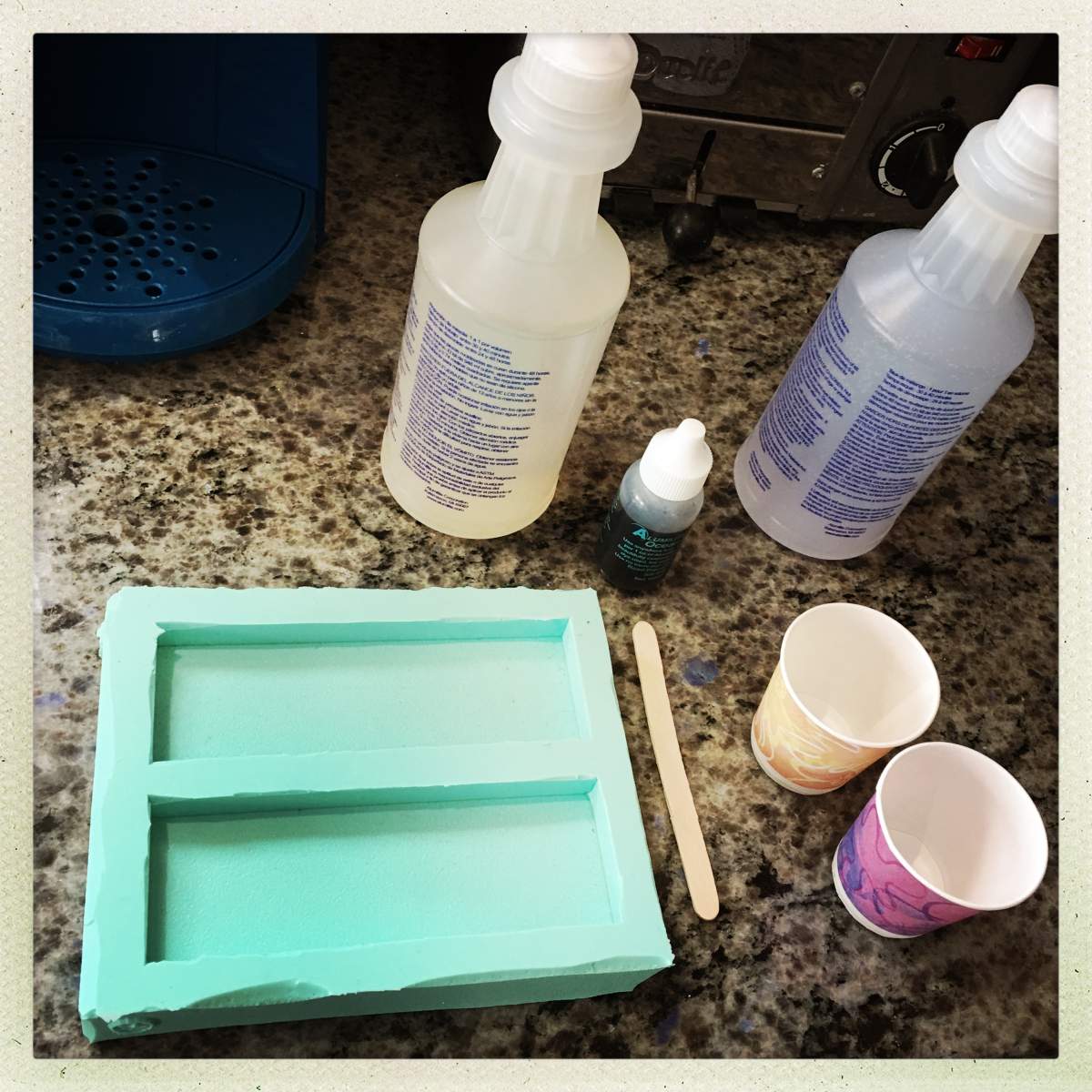
Start by laying everything out. If you’re not crazy, you’ll put down wax paper or polypropylene sheet to keep epoxy off your counter-top. I’ve gotten very good at just flicking cured epoxy off the stone with the edge of a knife.

Alumilite is mixed 1:1, resin and hardener, which should be at room temperature. Usually I put all my additives in one of the cups and then stir it in to get it looking right before adding it to the other. See the bamboo chopstick on the right? That’s the tip of what I used to get the glitter flakes (from the white jar).
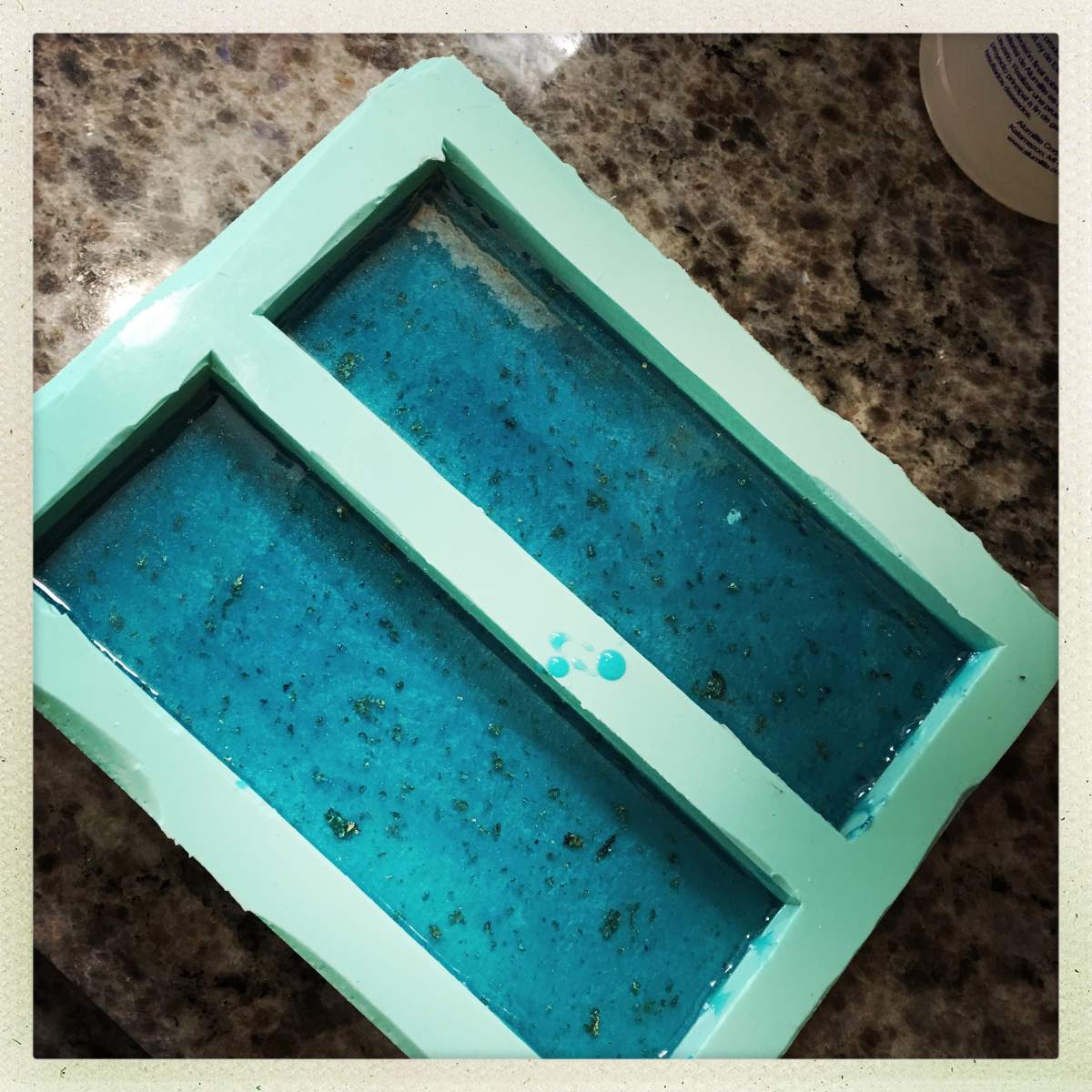
I also added some chopped gold leaf, because I thought it would look cool – and it does! I’m a patient person so I do most of my slabs in two pours. This has a huge advantage of allowing me to let gravity keep my objects in place (resin is heavy; anything lighter than resin will bob to the surface) – I do one pour and let it cure, then add more objects and do a top-off pour.
Here I have added the mixed resin to the mold. Next I arrange objects in it.
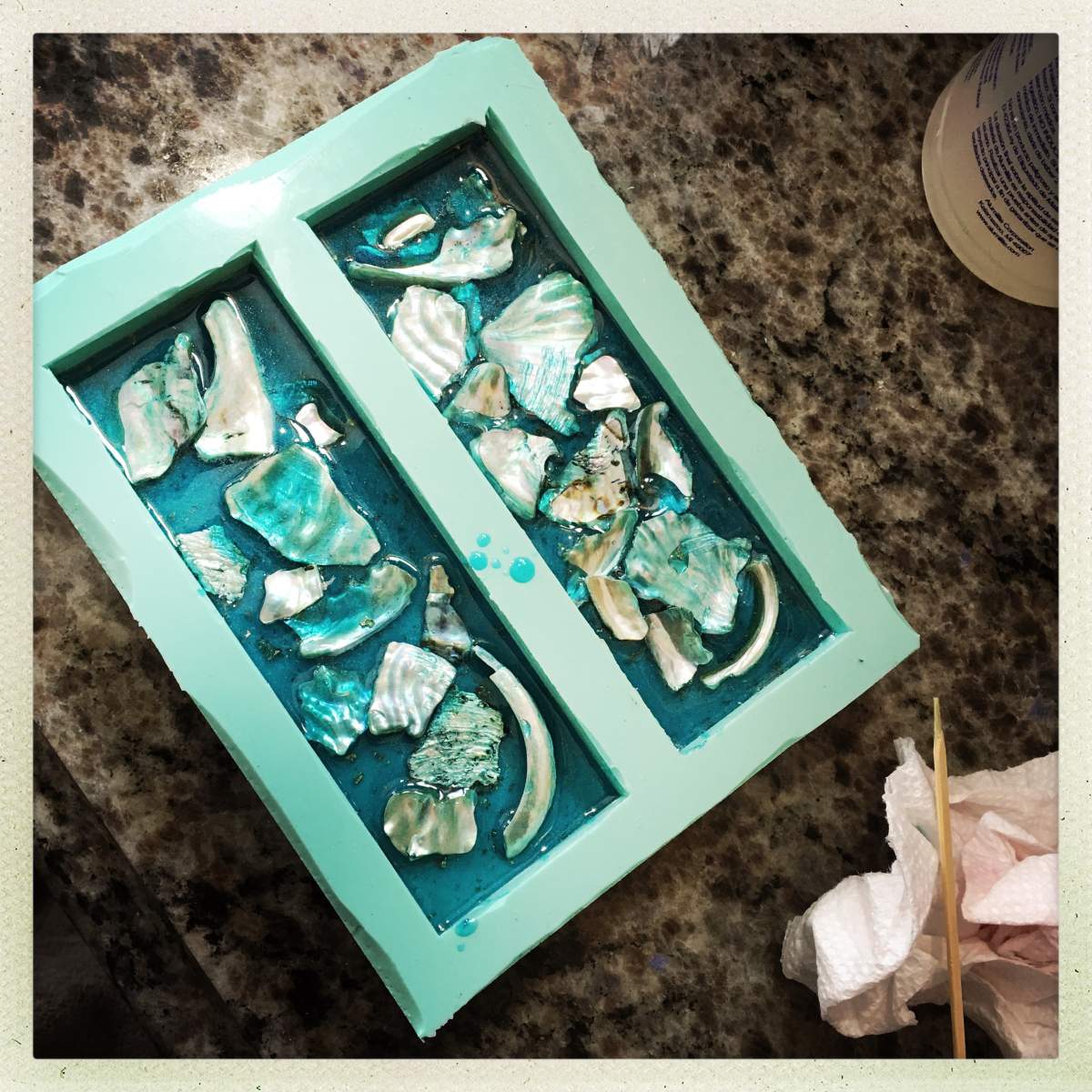
Chunks of broken abalone shell! About $12/lb on Ebay. I leave this on the radiator overnight so it cures. Epoxy cures with heat, so leaving it somewhere warm makes it cure nicely. Also: the mice don’t jump on the radiators much, so I won’t have little resin-covered mouse-prints all over the counter-top.
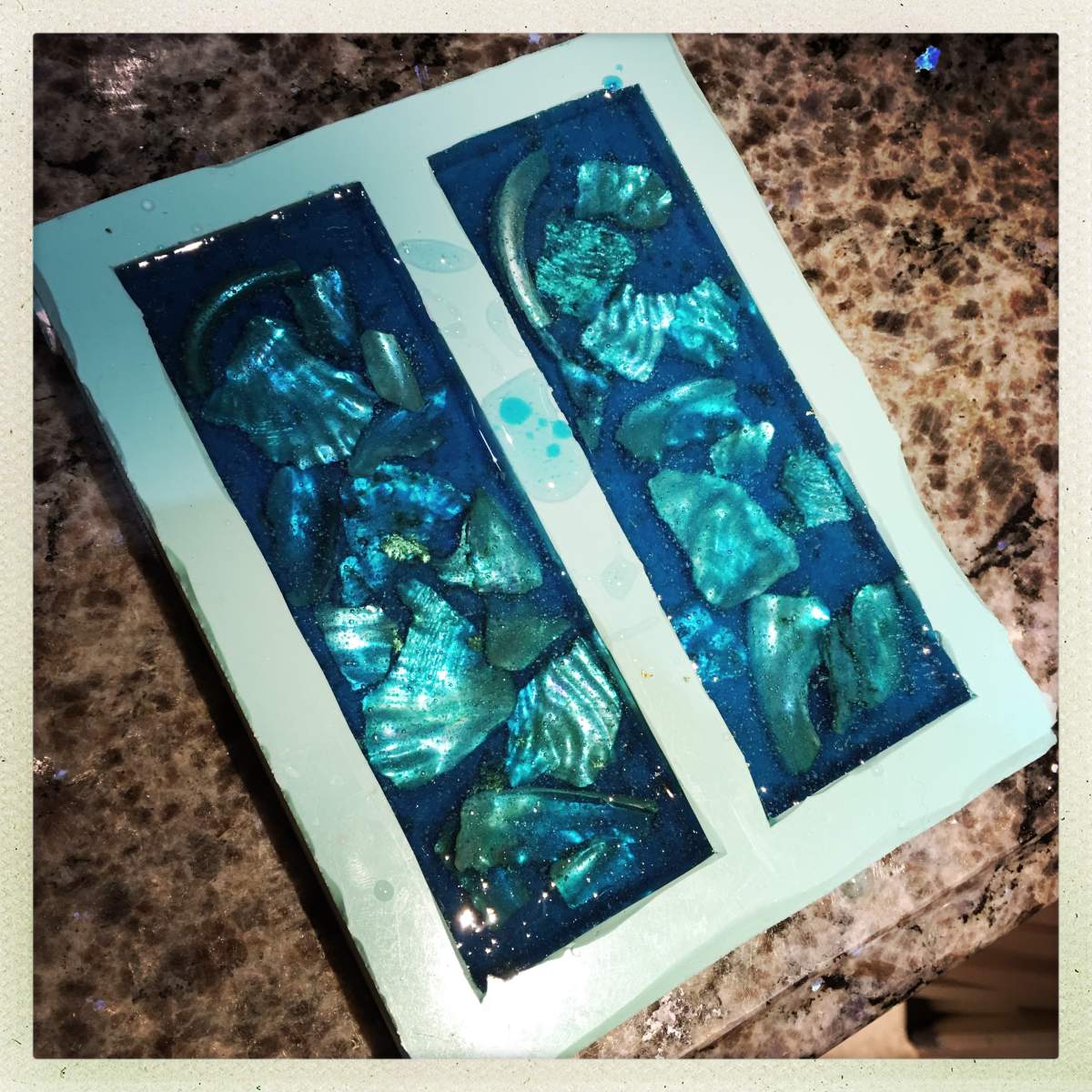
The next day, I add another few pieces of shell and make another batch of the same blue with gold flakes, then pour it on top.
Look at all the bubbles! They reach the surface and vanish within the first hour of curing. Put them back on the radiator for the night.
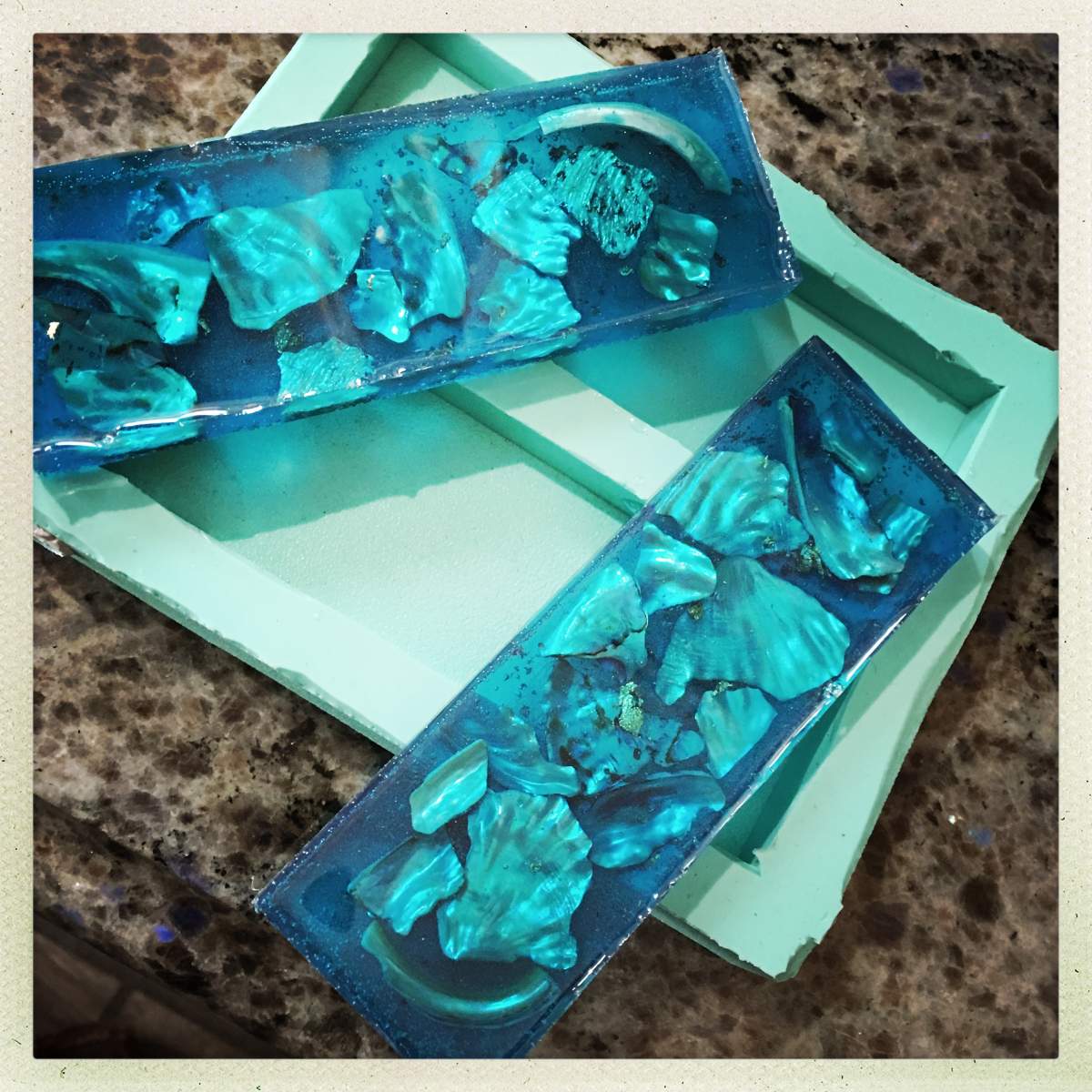
Demolded, the slabs are clear as water, and kind of pretty – like I intended.
I don’t have a knife to mount them on right now, and I’m not really sure if resin handles are my idea of a fun thing. Wood is my favorite and it’s actually much more predictable than resin and I don’t have to worry about solvents or incompatibility in glues.
Next up, I did a base layer in “smoke black” – that is to say, “a tiny bit of black pigment” and laid down a layer of Dentalia Aprinum shells (“white tusk” shells).

A nice thing about gluing everything down with a separate pour is that shells may hold air and it’s nice to be able to keep them down – also to arrange them so that the holes are open upward so that the next pour will sink down into the shells. This appears to be working well since the resin soaks a bit into the material.

Preparing for the over-pour, final layer.

Demolded, the next morning. I’m going to see if I can get these over to the shop and hit them with one of the grinders to see what the surface looks like once it’s shaped a bit.
There are many, many possibilities that can be explored. Some handle-makers use cactus-wood, driftwood, and even pinecones. I saw one handle made of mini pinecones that looked pretty cool once the handle was shaped through them. One modern style that the “tactical knife” set enjoy is to use aluminum hexagonal honeycomb, which strengthens the handle a bit and looks really neat when it’s shaped through. I have a friend who collects bones and she says she may be willing to give me a couple tablespoons of mouse and snake vertebrae from her collection of spare parts; I think those would look interesting in a black handle.
My next handle slab project is waiting for parts – I am going to try to do a dozen or two small pours of black with gold leaf interleaved between, so it looks sort of like damascus.
Here is a hint if you have trouble with matching colors: put all your colorants in “Part A” and make a batch of “Part A” with the colorant, then make batches from that for each ‘pour.’

The beginning of what will be multi-layers of blue and gold.
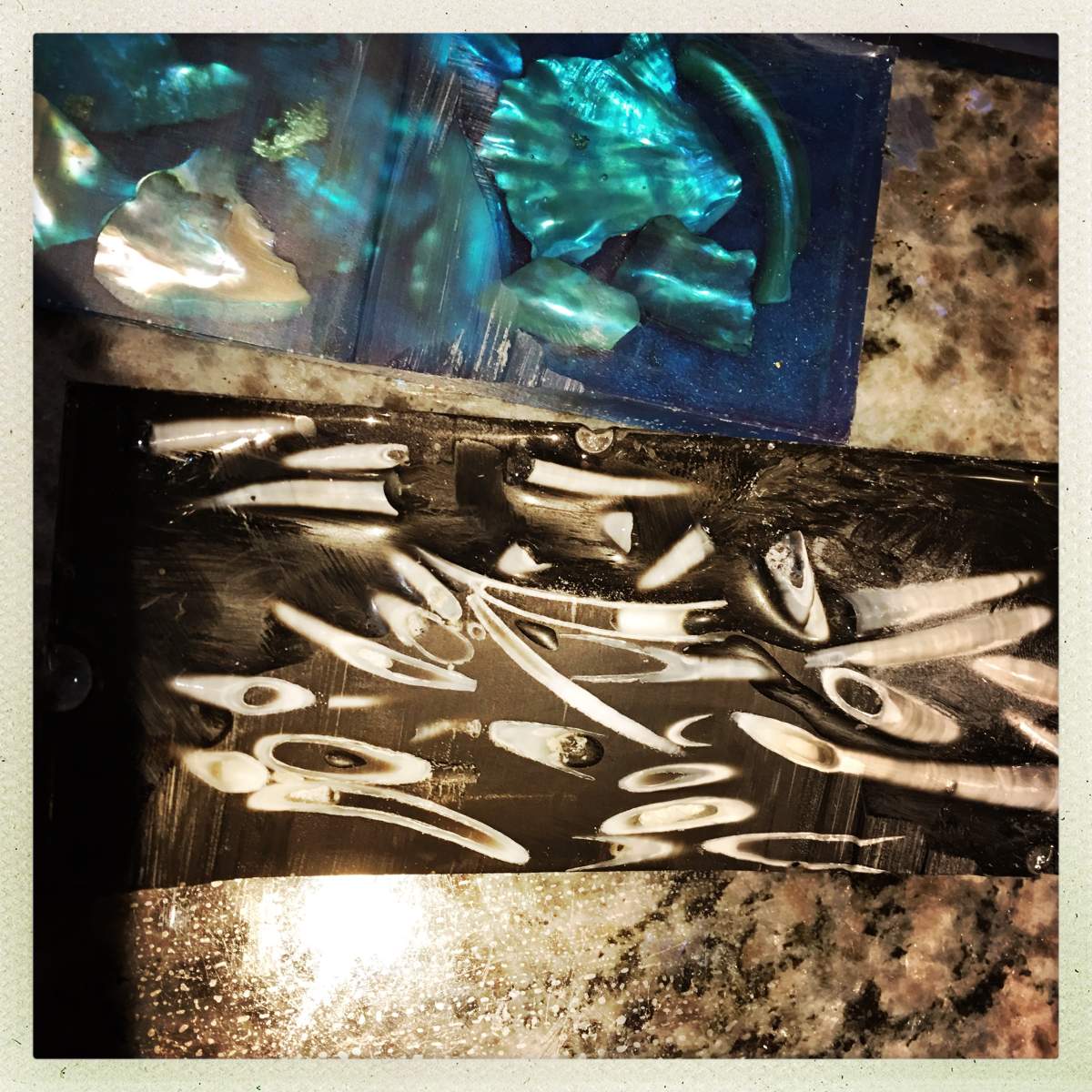
The slabs with shells, test-ground and polished with a 1200-grit sanding belt.

Gorgeous, not sure which I like best.
It looks pretty smooth, do you find the resin and shells grind ‘evenly’?
I have not seen this on a knife before but I was toying with the idea for some time now – even the one with small pine cones. Maybe I will try this sometime. I have already set aside pair of old jeans for experiments with making my own micarta.
But for the time being I prefer working with natural materials – bone and wood.
There is a guy on Etsy who casts in resin like this and then makes hair sticks out of the resin. A link: https://www.etsy.com/shop/TimberstoneTurnings/sold?ref=pagination&page=170 He puts things like feathers and Spanish moss, as well as pinecones and paua shell and dandelion fluff in there. It really turns out cool; he’s sold thousands of hair sticks. Of course he also has a laser and can put some pretty cool designs on his sticks too, plus he uses gemstones and dried flowers etc. etc.
Really nice to see the steps on how it’s done. That will make some pretty awesome knife handles!
Oh, crap – I forgot to add: @jazzlet: those Timberstone Turnings hair sticks are smooth as glass. It’s pretty amazing, really, how smooth that guy can get those sticks.
@ Kestrel thank you, he does amazing work, the moss especially. It’s a shame I don’t need hair sticks, mine will stay up if I knot it without pins or clips or sticks.
jazzlet@#1:
It looks pretty smooth, do you find the resin and shells grind ‘evenly’?
Seems to be pretty even. With a heavy grinder and an 80-grit belt, pretty much everything disappears more or less evenly and smoothly.
The resin gets a bit gooey as it heats up, and I had to clean the belt once. When it gets down to finer grits it really polishes up nicely. I did not enjoy the smell the resin releases when it’s hot. Wood is much nicer.
I hit the resin with the shells on a 1200-grit belt and it polishes up like glass.
Charly@#2:
I made a super cool polyethylene micarta press. I haven’t done a walkthrough on it, yet, but it “ought to work” – HDPE is wonderful material for these applications. I’ll see about making something show.
I experiment with this stuff, because I want to see what it’s like and a lot of people are all excited about it. I still don’t see anything as being as nice as good old wood. Wood is still, to me, the “wonder substance”
kestrel@#4:
It’s pretty amazing, really, how smooth that guy can get those sticks.
That’s one of the great things about a lathe: your work-piece spins and all you have to do is hold abrasives against it and instant-polish.
I can’t tell if he’s using a manual lathe or a CNC (I see a few spots where there is what appears to be CNC texturing) – if he’s using a CNC they are probably coming off the machine pre-polished. I’ve seen maple come out of a CNC machine and it’s pretty much ready for finish right off the machine.
@Marcus, #8: I would not be surprised. Remember, he has a laser… He is not fond of hours of labor-intensive polishing, and yet his pieces are just amazing in their smoothness. Amazing. I will say though, he quit doing 100% resin pieces because of issues. The sticks would sometimes break, and also, they would sometimes yellow. On the other hand, hair sticks are worn in the hair outside in the sunshine so perhaps that contributed to the issues. Knives are mostly used indoors… unless one is butchering an animal etc. So in the end, Doug went back to using mostly wood in his hair sticks.
@jazzlet, #8: I don’t “need” hair sticks either, actually, there are trees growing in my yard and I could just use a plain old stick sharpened in a pencil sharpener to hold up my hair. But on the other hand… why not use something so incredibly beautiful? Hair toys are one of my luxuries. I live on a farm and usually look like crap, but I am always confident that the back of my head looks amazing. :-D
kestrel@#9:
UV definitely can be a problem.
I’ve noticed a lot of people don’t think about archival permanence of materials. On the FaceBook knife101 group the prevailing attitude seems to be “glue is what holds knife handles together!” and people look at you funny if you tell them that polishing epoxy resin with butcher’s wax (turpentine and beeswax) is not compatible. Then we have to have the whole “different solvents are incompatible with different materials” discussion all over again. It’s interesting – I think coming from a background in vintage process photography you understand that things stain and weaken each other, or make things peel off or not stick, etc.
Charly@#2:
I have already set aside pair of old jeans for experiments with making my own micarta.
But for the time being I prefer working with natural materials – bone and wood.
It’s fun to make and very strong. I’m not so fond of how it smells when you’re grinding it.
I still think wood is pretty much the wonder-material.
Fascinating but weird. I’m a former professional cook and a knife is a tool.
Oh, we are willing to pay large amounts of money for the right knife and we can be very possessive of our best knives. Weight, size, balance, ability to hold an edge, yes, but the handle?
It’s like gussying up the handle of your screwdriver.
Clearly my artistic sense is deficient.
So far it looks great. Snake vertebrae sound promising too.
UV definitely can be a problem.
I’ve noticed a lot of people don’t think about archival permanence of materials. On the FaceBook knife101 group the prevailing attitude seems to be “glue is what holds knife handles together!” and people look at you funny if you tell them that polishing epoxy resin with butcher’s wax (turpentine and beeswax) is not compatible. Then we have to have the whole “different solvents are incompatible with different materials” discussion all over again.
Yes, it’s identical for artists. I find it surprising that so many artists choose to use paints that are not lightfast. The worst offender is the alizarin crimson pigment. I understand that artists used it 100 years ago, because then there were no better alternatives. It took chemists a lot of effort to discover good pigments, and many of them weren’t available until recently. But it is stupid to keep on using alizarin crimson pigment nowadays, when there are numerous other options, for example, quinacridone red, perylene maroon, cadmium red pigments. Yet artists still keep on using it, because “that’s what the old masters used,” and many paint manufacturers still offer alizarin crimson in all painting media in the name of being traditional. I doubt that artists don’t care. Probably they simply don’t know about how lightfast each one of their paints is. Of course, it’s not just this one pigment. There are several pigments that have poor lightfastness, it’s just that alizarin crimson is the worst among the widely used problematic pigments.
Besides lightfastness in pigments, there are also problems with some papers. If the paper isn’t acid-free, it will yellow over time.
The examples I gave so far just barely scratch the surface of what can potentially go wrong with an artwork. Once you start painting with oils on canvas, things get a lot more complicated. If the artist uses the wrong stuff, their paintings just disintegrate over time.
It’s interesting – I think coming from a background in vintage process photography you understand that things stain and weaken each other, or make things peel off or not stick, etc.
Personally, I know all this stuff because I’m a geek who finds it interesting to read about the history and chemical properties of art materials. I actually perceive chemistry as fun. I definitely don’t fit the stereotype of the creative artist, I have been told that I should have become a scientist instead. I find it great that, in order to make cool artworks, I don’t even need to be creative. It’s perfectly possible to approach painting rationally instead of just getting inspiration and being creative.
I simply love them.
What do I have to do to make you make me a bunch of buttons I can glue to magnets?
jrkrideau@#12:
Oh, we are willing to pay large amounts of money for the right knife and we can be very possessive of our best knives. Weight, size, balance, ability to hold an edge, yes, but the handle?
It’s like gussying up the handle of your screwdriver.
Ok, I am of several minds on this. First off: always, relentlessly, always, the best blade that can be made with the materials chosen for the purpose. Since you’ve used knives professionally, you know that’s more about the shape of the blade than almost anything else.
As far as handle materials – some knives can (and should) be beautiful. Or they can be tools. I am of many different minds on this subject. Right now, I think I would probably be making handle slabs out of copper/bronze mokume, if I were geared up to do it without splashing hot stuff around. There are materials that are nearly indestructible, they’re just heavy, so drill them out in the back or machine them hollow.
If you are on instagram, I suggest you take a look at Helen DesRosiers’ [instagram] knives. All I can say is “daaaaaaaaaaaaaang.”
Anyway, there are knife-makers who have realized that they can get insane prices if they promote their knives as insanely priced and then discount deal under the table. I laugh at this all the time; it’s the same trick car dealers used for 50 years and that’s why: it works. Some of those high-priced knives are doubtless excellent and certainly beautiful but a well-ground piece of high carbon steel with a nice wood handle soaked in oil is going to perform exactly as well for exactly the same amount of time.
Gilliell@#14:
What do I have to do to make you make me a bunch of buttons I can glue to magnets?
How big?
Do you mean literally buttons, like for sewing, or buttons like the dome-shaped pin-on things?
More like these. You know, for a simple magnetic board to hold all the various notes and bills to pay and stuff
@ 15 Marcus
Re Helen DesRosiers
Uh yes? Does nothing for me except a nice looking french knife and a rather desirable Chinese cleaver.
I guess I can see the rationale but your line “ a well-ground piece of high carbon steel with a nice wood handle soaked in oil” destroys it. Why would anyone want anything other than “ a nice wood handle soaked in oil”? Best French knife I ever had.
This sounds ideal to me. Admittedly I am a philistine in this area.
I do salivate over really good knives.